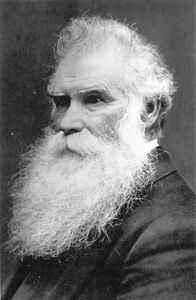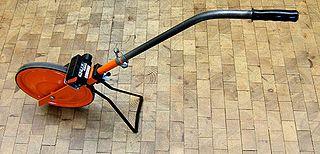
An odometer or odograph is an instrument used for measuring the distance traveled by a vehicle, such as a bicycle or car. The device may be electronic, mechanical, or a combination of the two (electromechanical). The noun derives from ancient Greek ὁδόμετρον, hodómetron, from ὁδός, hodós and μέτρον, métron ("measure"). Early forms of the odometer existed in the ancient Greco-Roman world as well as in ancient China. In countries using Imperial units or US customary units it is sometimes called a mileometer or milometer, the former name especially being prevalent in the United Kingdom and among members of the Commonwealth.

A tachometer is an instrument measuring the rotation speed of a shaft or disk, as in a motor or other machine. The device usually displays the revolutions per minute (RPM) on a calibrated analogue dial, but digital displays are increasingly common.

The Mormon Trail is the 1,300-mile (2,100 km) long route from Illinois to Utah on which Mormon pioneers traveled from 1846–47. Today, the Mormon Trail is a part of the United States National Trails System, known as the Mormon Pioneer National Historic Trail.

A speedometer or speed meter is a gauge that measures and displays the instantaneous speed of a vehicle. Now universally fitted to motor vehicles, they started to be available as options in the early 20th century, and as standard equipment from about 1910 onwards. Other vehicles may use devices analogous to the speedometer with different means of sensing speed, eg. boats use a pit log, while aircraft use an airspeed indicator.

The Mormon pioneers were members of the Church of Jesus Christ of Latter-day Saints, also known as Latter-day Saints, who migrated beginning in the mid-1840s until the late-1860s across the United States from the Midwest to the Salt Lake Valley in what is today the U.S. state of Utah. At the time of the planning of the exodus in 1846, the territory comprising present-day Utah was part of the Republic of Mexico, with which the U.S. soon went to war over a border dispute left unresolved after the annexation of Texas. The Salt Lake Valley became American territory as a result of the Treaty of Guadalupe Hidalgo, which ended the war.

Orson Pratt Sr. was an American religious leader and mathematician who was an original member of the Quorum of the Twelve Apostles of the Church of Christ. He became a member of the Quorum of the Twelve of the Church of Jesus Christ of Latter-day Saints and was a leading Mormon theologian and writer until his death.

The south-pointing chariot was an ancient Chinese two-wheeled vehicle that carried a movable pointer to indicate the south, no matter how the chariot turned. Usually, the pointer took the form of a doll or figure with an outstretched arm. The chariot was supposedly used as a compass for navigation and may also have had other purposes.

William H. Clayton was a clerk, scribe, and friend to the religious leader Joseph Smith. Clayton, born in England, was also an American pioneer journalist, inventor, lyricist, and musician. He joined the Church of Jesus Christ of Latter Day Saints in 1837 and served as the second counselor to the British mission president Joseph Fielding while proselyting in Manchester. He led a group of British converts in emigrating to the United States in 1840 and eventually settled in Nauvoo, Illinois, where he befriended Joseph Smith and became his clerk and scribe. He was a member of the Council of Fifty and Smith's private prayer circle.

A cyclocomputer, cycle computer, cycling computer or cyclometer is a device mounted on a bicycle that calculates and displays trip information, similar to the instruments in the dashboard of a car. The computer with display, or head unit, usually is attached to the handlebar for easy viewing. Some GPS watches can also be used as display.

A surveyor's wheel, also called a clickwheel, hodometer, waywiser, trundle wheel, measuring wheel or perambulator is a device for measuring distance.
Appleton Milo Harmon was an American farmer, businessman, and builder known as an early member of the Church of Jesus Christ of Latter-day Saints and a leading pioneer of the emigration to Salt Lake City and settlement of Utah Territory.

Mechanical counters are digital counters built using mechanical components. Long before electronics became common, mechanical devices were used to count events. They typically consist of a series of disks mounted on an axle, with the digits zero through nine marked on their edge. The right most disk moves one increment with each event. Each disk except the left-most has a protrusion that, after the completion of one revolution, moves the next disk to the left one increment. Such counters were used as odometers for bicycles and cars and in tape recorders and fuel dispensers and to control manufacturing processes. One of the largest manufacturers was the Veeder-Root company, and their name was often used for this type of counter. Mechanical counters can be made into electromechanical counters, that count electrical impulses, by adding a small solenoid.
Clayton's Guide, Clayton's Emigrant Guide, or as when published, The Latter-Day Saints' Emigrants' Guide, published by Missouri Republican Steam Power Press, Chambers & Knapp, 1848 and written by William Clayton, was one of a number of very popular guidebooks written to support the westward expansion of the United States in the mid-nineteenth century when organized emigrant wagon trains began to form in large numbers at various river ports on the Missouri River.
Chalk Creek is a stream in Millard County, Utah, United States.
Fremont Wash sometimes called Fremont Canyon in its upper reach, is a stream and a valley in the north end of Parowan Valley, in Iron County, Utah. Its mouth lies at its confluence with Little Salt Lake at an elevation of 5,686 feet. Its head is found at 38°07′46″N112°34′36″W, the mouth of Fremont Canyon, an elevation of 6,476 feet.
Parowan Creek, is a stream in the Parowan Valley of Iron County, Utah. It flows north through Parowan, Utah to its mouth at an elevation of 5,686 feet at the Little Salt Lake in Parowan Valley. Its source is located at an elevation of 9,980 feet at 37°40′57″N112°51′16″W in Brian Head, Utah in the Markagunt Plateau.
Mormon Road, also known to the 49ers as the Southern Route, of the California Trail in the Western United States, was a seasonal wagon road pioneered by a Mormon party from Salt Lake City, Utah led by Jefferson Hunt, that followed the route of Spanish explorers and the Old Spanish Trail across southwestern Utah, northwestern Arizona, southern Nevada and the Mojave Desert of California to Los Angeles in 1847. From 1855, it became a military and commercial wagon route between California and Utah, called the Los Angeles – Salt Lake Road. In later decades this route was variously called the "Old Mormon Road", the "Old Southern Road", or the "Immigrant Road" in California. In Utah, Arizona and Nevada it was known as the "California Road".
Indian Creek originally known as Sage Creek, is a tributary stream of the Beaver River in Beaver County, Utah. Its mouth is at its confluence with the Beaver River at an elevation of 5,499 feet above the Minersville Reservoir, 0.4 miles south of Adamsville. Its source is at 38°24′31″N112°26′55″W, on the northwest slope of Mount Baldy at an elevation of 10,600 feet in the Tushar Mountains.
Johnson Creek, originally known as Cottonwood Creek, is a stream in iron County, Utah, United States. Its mouth is in the Cedar Valley at an elevation of 5,407 feet (1,648 m), 1.5 miles (2.4 km) south of Rush Lake, where is dissipates into the ground. Its source is a group of springs, formerly known as Elkhorn Springs, later Johnson Springs, running from north to south, at the foot of the south end of the Red Hills at 37°46′32″N113°01′31″W at an elevation of 5,500 to 5,510 feet in what is now Enoch, Utah.












